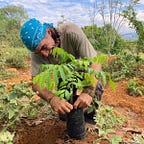Weaving Networks of Regenerative Projects
Wondering how you can make a difference? Wishing there was a global movement you could join that truly has the potential to safeguard humanity’s future in the midst of catastrophic planetary collapse? It’s very late in the game, but hope remains — read on to find out how you can get involved.
It is common knowledge that the Earth is in overshoot-and-collapse. This can readily be seen by looking at the “planetary boundaries” framework developed by the Stockholm Resilience Center that shows how humanity has already crossed four of the nine thresholds that define a safe operating space for our global civilization.
What most people don’t know is that there is a pathway for regeneration to undo this damage in the coming decades. Projects exist today that restore ecosystems, increase biodiversity, capture and store carbon in the soil, and more — all while increasing the health and resilience of the people living in them.
My family recently moved to one of these projects in Costa Rica. We are living on a self-sufficient ranch and ecotourism resort called Rancho Margot that has been running for 15 years in environmentally positive ways that are also economically viable.
Let this sink in. If we can do it, you can too!
Each project on its own doesn’t seem to make a difference. And in truth, no project on its own CAN make a difference. But TOGETHER we can achieve great things. Look carefully at the planetary boundaries we have crossed in the image above and you will notice that 85% of the harm is related to industrial agriculture. The way we grow our food involves poisoning the land; having it run off into rivers, lakes, and oceans; while displacing or destroying vital ecosystems; all the while making people less healthy as the quality of food declines.
Imagine if all of the ecological farming techniques that have been developed over the last 50 years were to somehow spread worldwide and become the dominant mode of food production. This alone would go a long way towards avoiding the worst of climate change while buffering hundreds of millions (if not billions) of people from starvation and the violence that quickly follows when people no longer have stable food supplies.
But this is only scratching the surface of what can — indeed must — be done. A great deal is also known about how to create “circular” economies based on regenerative economic principles. Holistic and systemic understandings now exist for how human societies can organize themselves such that sustainability, health, and resilience “pop out” as emergent properties due to their interactions.
I have recently taken a role with the Regenerative Communities Network to build a global tapestry of these real-world projects. Our vision is to bring as much of humanity as possible back into harmony with the rest of nature. We are doing this now and there’s no time to waste.
We are part of a much larger movement that has been coalescing in recent years. This article by Daniel Christian Wahl outlines the explosive growth of regeneration. The photo at the top of this essay shows the Global Ecovillage Network. Add to it the landscape restoration projects of Ecosystem Restoration Camps, new economic practices being embedded in Transition Towns around the world, spread of regenerative farming across the hubs of Savory Institute, and the launch of bioegional projects to coordinate entire regions and you begin to glimpse what is possible today.
You can get involved by joining any or all of these efforts. The important thing is that local people are doing things that can be networked to achieve global goals. Consider the “donut” economics framework. When we begin to see how different nations fail to achieve social goals while over-consuming the rest of nature, it becomes possible to focus our attention on these deficits.
One way to regenerate our planet is to first regenerate the local ecosystems of local places. Then we measure our progress toward national targets of health and resilience as we coordinate across regions to move toward planetary health outcomes. Sounds easy in principle, but this is really going to be hard. In fact it is probably the most difficult thing humans have ever done!
So we’d better get started. For my part, I am offering a series of workshops on regenerative design to help bring greater coherence to existing networks. You can join any of the projects above (or start your own!) and weave a tapestry of regeneration for the thriving of future generations.
Onward, fellow humans.
Joe Brewer is the executive director of the Center for Applied Cultural Evolution. Get involved by signing up for our newsletter and consider making a donation to support our work.
